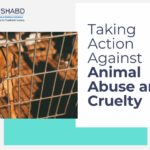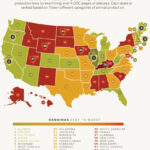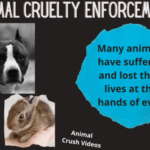In an age where fashion and individual expression are celebrated, the phrase “Who wore it better?” has woven itself into the fabric of our cultural dialogue. It casts a playful query upon celebrities, fashion icons, and everyday consumers alike, prompting comparisons of aesthetic choices and personal style. While this seemingly innocuous question may elicit playful banter among enthusiasts, it belies a far graver reality that often lurks beneath the surface—particularly in relation to the fur industry. The ramifications of this question extend well beyond fashion runways and Instagram feeds; they raise profound ethical concerns regarding the treatment of animals exploited for their skins.
The allure of furs historically evokes images of luxury and opulence. Yet, this glamour is inextricably linked to the brutal realities encountered by countless animals. In evaluating fashion statements, it becomes crucial to recognize the intrinsic value of the lives lost for the sake of aesthetic indulgence. Each piece of fur is not merely a material choice but a somber reminder of suffering endured by animals confined to cages, subjected to inhumane conditions, and ultimately killed for their pelts.
The process by which animals are collected for their fur often involves capture methods that are anything but benign. Traps employed to ensnare animals can lead to prolonged agony, inflicting injuries that are seldom addressed until it is too late. Many animals, such as minks and foxes, are raised on fur farms where they live in cramped, squalid conditions, devoid of basic freedoms. Here lies a disconcerting juxtaposition: while some individuals ponder over the aesthetic merits of a fur coat, the reality is that their fashion choices perpetuate a cycle of cruelty and exploitation. The inquiry “Who wore it better?” disregards the collective suffering in favor of comparison.
In the contemporary discourse surrounding ethical fashion, the deleterious implications of promoting fur are becoming more prominent. Advocates for animal rights argue that the perpetuation of such questions might unintentionally normalize the idea that animal suffering is a trivial concern beneath the shimmering allure of style. Ignoring the plight of these sentient beings while engaging in frivolous comparisons enriches the narrative of fashion over ethics, ultimately distracting society from the moral considerations that the fur industry demands.
When pondering the societal obsession with fashion images, one may consider the pervasive marketing strategies employed by the fur industry. These campaigns often glamorize fur, depicting it as an essential element of status and sophistication. In this context, ‘the question of who wore it better’ becomes a tool for further entrenching a glorified image of fur, effectively overshadowing the darker truths of animal exploitation. By valorizing personalities who choose to don fur, an impression is cultivated that glamorizes cruelty, thereby perpetuating a problematic narrative.
Yet, there exists a growing response to this industry. Ethical considerations are increasingly shifting consumer preferences towards cruelty-free alternatives. As awareness skyrockets, discussions surrounding sustainably sourced materials, vegan furs, and second-hand clothing options are gaining traction. Consumers are beginning to understand that embodying compassion does not diminish style; instead, it enriches personal identity and fosters a connection to broader moral imperatives.
Nonetheless, the allure of fleeting trends often hampers this progress. The rapid pace of the fashion industry leads to disposable behaviors, compelling individuals to acquire and discard items without consideration of their ethical implications. In this relentless quest for the next big trend, the question of “who wore it better” serves not only as a frivolous distraction but also as an catalyst for pernicious consumer behavior that supports the fur industry. The cycle perpetuates an ethos wherein animal suffering remains hidden behind the veil of glamorous fashion.
Moreover, this question invites deeper contemplation regarding the anthropocentric lens through which we view clothing. It is imperative to challenge the narrative that prioritizes human aesthetics over animal welfare. Instead of framing discussions around who presents fur in a more appealing manner, we can advocate for a shift towards the question: why should fur be worn at all? This reframing acknowledges the profound consequences that choices have on living beings and encourages a more compassionate approach to fashion.
As we navigate through the world of fashion, it is essential to question the underlying messages transmitted by popular culture. Engaging critically with the phrase “Who wore it better?” necessitates an examination of the ethical dimensions surrounding animal rights, welfare, and dignity. The ongoing dialogue presents a challenge not just for fashion enthusiasts, but for citizens at large. It implores each of us to consider the implications of our consumption patterns and how they resonate within broader societal contexts.
In redefining our approach to fashion, we also pave the way for a more compassionate future. By actively choosing to support brands that eschew animal products and promote sustainability, we become architects of change. We can collectively reject the notion that animal suffering must be sacrificed at the altar of aesthetics, steering the conversation towards a more ethical understanding of fashion—a dialogue that champions kindness and integrity.
In conclusion, the whimsical inquiry about who wore it better serves as a gateway into profound ethical considerations concerning fur. Distancing ourselves from the allure of comparative judgments allows for a greater contemplation of the realities faced by animals in the fur industry. In doing so, we reaffirm our commitment to a future where fashion does not equate to cruelty, and where compassion reigns over superficiality. Let us abandon this trivial comparison and redirect our focus to a narrative that celebrates life, dignity, and genuine style—one that respects both human creativity and animal welfare.







